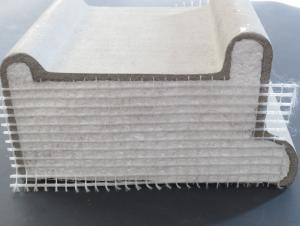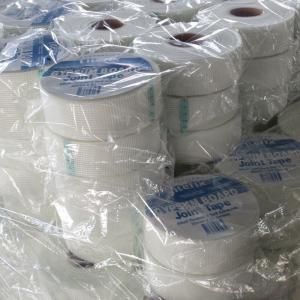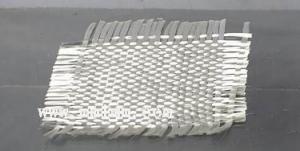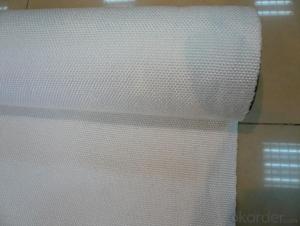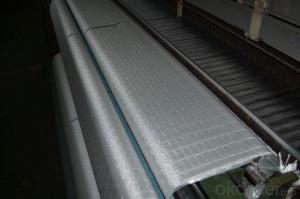High Silica Fiberglass Fabrics with Good Quality
- Loading Port:
- China Main Port
- Payment Terms:
- TT OR LC
- Min Order Qty:
- -
- Supply Capability:
- -
OKorder Service Pledge
Quality Product, Order Online Tracking, Timely Delivery
OKorder Financial Service
Credit Rating, Credit Services, Credit Purchasing
You Might Also Like
Quick Details
| Place of Origin: | Brand Name: | Model Number: | |||
| Shape: |
Packaging & Delivery
| Packaging Detail: | wooden case |
| Delivery Detail: | according to the quantity of order, but not longer than 30 days |
Specifications
Material:fiber glass
Technics:Other
Model Number:0.8-2.0mm
Connection: Other
Shape:roll
- Q: Can fiberglass fabrics be used for insulation in cryogenic storage tanks?
- Yes, fiberglass fabrics can be used for insulation in cryogenic storage tanks. Fiberglass is a commonly used material for insulation due to its low thermal conductivity and high resistance to extreme temperatures. In cryogenic storage tanks, where materials need to be kept at very low temperatures, fiberglass fabrics can provide effective thermal insulation to minimize heat transfer. The fabric can be applied as a layer or wrapped around the tank to create a barrier that prevents the escape of cold temperatures and the entry of external heat. Additionally, fiberglass fabrics are lightweight and flexible, making them easy to install and handle in the construction and maintenance of cryogenic storage tanks.
- Q: Can fiberglass fabric be used for filtration applications?
- Yes, fiberglass fabric can be used for filtration applications. It is commonly used in industries such as chemical processing, gas and air filtration, water treatment, and automotive manufacturing. The material's high strength, durability, and resistance to chemicals make it an effective choice for filtering out contaminants in various applications.
- Q: What kind of fiberglass cloth is used for neoprene waterproofing coating?
- Generally can be divided into solvent and emulsion!
- Q: Can fiberglass fabric be used for making bookbinding material?
- Yes, fiberglass fabric can be used for making bookbinding material. Fiberglass fabric is a versatile material that is known for its strength, durability, and resistance to wear and tear. It can be used as a reinforcement material in bookbinding to provide added strength and stability to the covers and spines of books. It can also be used as a protective layer to prevent damage to the pages and bindings of books. However, it is important to note that fiberglass fabric can be quite rigid and may not be suitable for certain types of bookbinding projects that require flexibility or a softer touch. Therefore, it is recommended to assess the specific requirements of the bookbinding project before deciding to use fiberglass fabric.
- Q: Is fiberglass fabric resistant to chemicals in swimming pools?
- Fiberglass fabric is known for its ability to resist chemicals typically found in swimming pools. It is a strong and durable material that is often used in constructing swimming pools because of its exceptional resistance to chemicals. Fiberglass can withstand chlorine, bromine, and other commonly used pool water treatments without being damaged. This resistance allows fiberglass fabric to maintain its strength and appearance, making it an excellent choice for pool linings, covers, and other applications exposed to pool chemicals. However, it's important to note that prolonged exposure to highly concentrated or extremely harsh chemicals may eventually cause some degradation or discoloration of the fiberglass fabric. Therefore, regular maintenance and proper care are crucial to ensure the long-lasting performance of fiberglass fabric in swimming pool environments.
- Q: Are fiberglass fabrics suitable for use in medical or healthcare settings?
- Fiberglass fabrics are indeed appropriate for usage in medical or healthcare settings. They possess a variety of characteristics that render them perfect for application in such environments. To start with, fiberglass fabrics are renowned for their remarkable strength and durability. This quality makes them well-suited for items like medical gowns, drapes, and curtains, which must endure frequent handling and washing. The sturdy and tear-resistant nature of fiberglass fabrics ensures their ability to withstand the demanding conditions of everyday use in healthcare facilities. Furthermore, fiberglass fabrics exhibit exceptional chemical resistance, making them commonly utilized in medical settings where exposure to various substances is commonplace. Their high resistance to solvents, acids, and bases renders them ideal for protective aprons, gloves, or masks that provide a barrier against hazardous materials. Additionally, fiberglass fabrics possess excellent thermal insulation properties. This proves particularly advantageous in medical settings where maintaining a stable temperature is crucial, such as in incubators or thermal blankets. The thermal insulation properties of fiberglass fabrics aid in ensuring patient comfort and safety. Moreover, fiberglass fabrics can be manufactured with antimicrobial properties, which play a crucial role in preventing the growth and spread of bacteria and other microorganisms in healthcare settings. The use of antimicrobial fiberglass fabrics in bedding, curtains, or privacy screens helps to diminish the risk of infection transmission. Finally, fiberglass fabrics are lightweight and breathable, enabling proper air circulation and moisture management. This is of utmost importance in medical or healthcare settings, as it prevents moisture buildup, which can lead to the proliferation of bacteria or fungi. The breathability of fiberglass fabrics also ensures patient comfort and reduces the risk of skin irritations. In conclusion, fiberglass fabrics possess a range of properties that make them suitable for application in medical or healthcare settings. Their strength, chemical resistance, thermal insulation, antimicrobial properties, and breathability make them ideal for various purposes in these environments, thereby ensuring the safety, comfort, and well-being of both patients and healthcare professionals.
- Q: Can fiberglass fabric be used for reinforcement in chemical processing tanks?
- Yes, fiberglass fabric can be used for reinforcement in chemical processing tanks. Fiberglass fabric is known for its excellent chemical resistance, making it an ideal choice for applications in which the tank is exposed to a wide range of corrosive chemicals. It is also lightweight and has high strength, which helps in reinforcing the tank structure and improving its durability. Additionally, fiberglass fabric can be easily molded and shaped to fit the tank's specific design requirements, making it a versatile material for reinforcement in chemical processing tanks.
- Q: Can fiberglass fabrics be used for reinforcement purposes?
- Yes, fiberglass fabrics can be used for reinforcement purposes. They are commonly utilized in various industries including automotive, aerospace, construction, and marine, to reinforce structures and achieve higher strength and durability. The inherent properties of fiberglass, such as high tensile strength, corrosion resistance, and lightweight nature, make it an excellent choice for reinforcement applications.
- Q: How does fiberglass fabric perform in weight-to-strength ratio?
- Fiberglass fabric has a relatively high weight-to-strength ratio, meaning that it is lightweight yet offers significant strength and durability. This is due to the unique composition of fiberglass, which is made up of tiny glass fibers woven together. These fibers are extremely strong and rigid, allowing the fabric to withstand high levels of tension and compression. Compared to other materials such as steel or aluminum, fiberglass fabric is significantly lighter while still maintaining comparable strength. This makes it an ideal choice for applications where weight is a critical factor, such as in the aerospace or automotive industries. Additionally, the high strength of fiberglass fabric allows for the construction of structures and components that can withstand heavy loads without adding excessive weight. The weight-to-strength ratio of fiberglass fabric can be further optimized by adjusting the fabric's weave pattern and the density of the glass fibers. For example, a tighter weave or a higher density of fibers can increase the fabric's strength, but may also increase its weight. Conversely, a looser weave or lower fiber density can reduce weight but may sacrifice some strength. Overall, fiberglass fabric performs admirably in terms of weight-to-strength ratio, offering a lightweight and strong material that can be used in a wide range of applications. Its versatility and durability make it a popular choice for various industries, where the balance between weight and strength is crucial.
- Q: Can fiberglass fabric be used for insulation in storage tanks?
- Fiberglass fabric is indeed suitable for insulation in storage tanks. Its remarkable thermal properties make it an optimal selection for insulation purposes. With its low thermal conductivity, it effectively diminishes heat transfer and maintains the desired temperature of the storage tank contents. Moreover, fiberglass fabric offers the advantages of being lightweight, flexible, and easy to install, rendering it a convenient alternative for insulating storage tanks of diverse sizes and shapes. Additionally, it possesses resistance against moisture, chemicals, and UV radiation, guaranteeing its durability and long lifespan. All in all, fiberglass fabric stands as a trustworthy and effective option for insulating storage tanks.
Send your message to us
High Silica Fiberglass Fabrics with Good Quality
- Loading Port:
- China Main Port
- Payment Terms:
- TT OR LC
- Min Order Qty:
- -
- Supply Capability:
- -
OKorder Service Pledge
Quality Product, Order Online Tracking, Timely Delivery
OKorder Financial Service
Credit Rating, Credit Services, Credit Purchasing
Similar products
Hot products
Hot Searches
Related keywords







